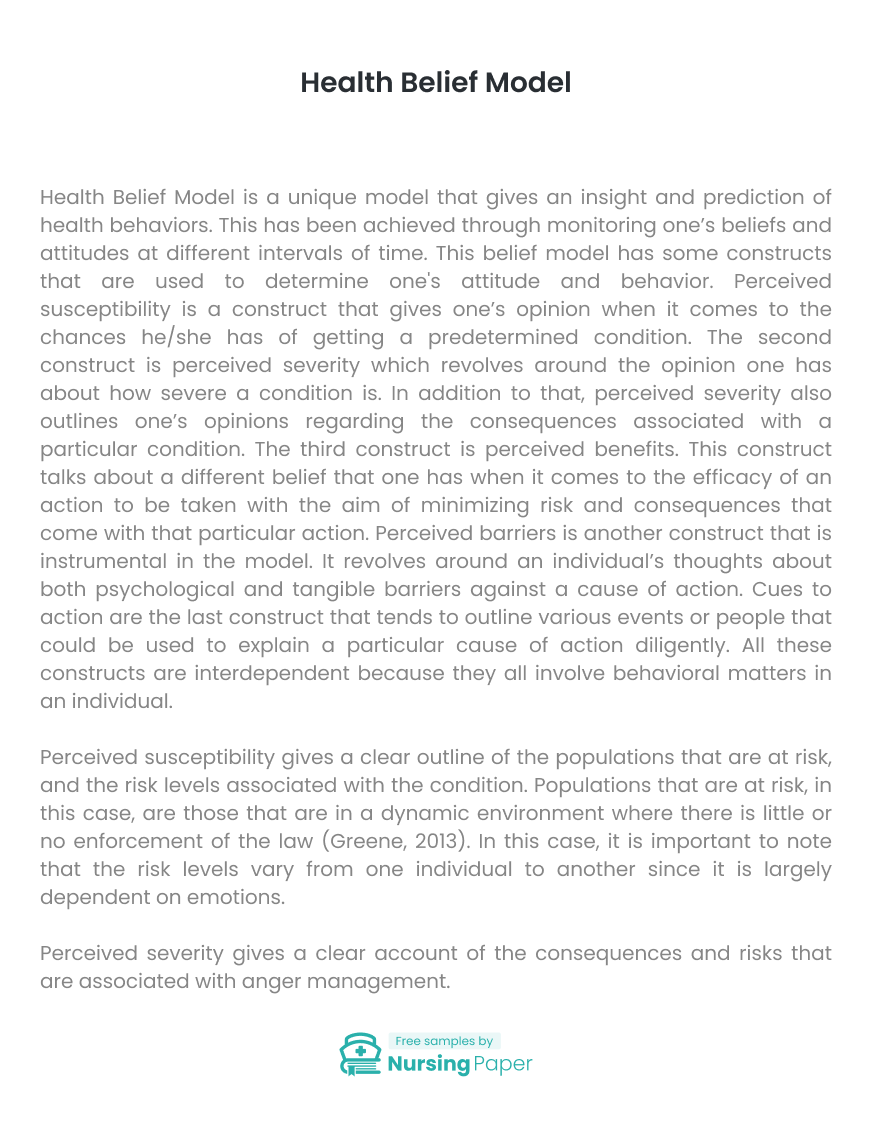
Health Belief Model
Part One
Health Belief Model is a unique model that gives an insight and prediction of health behaviors. This has been achieved through monitoring one’s beliefs and attitudes at different intervals of time. This belief model has some constructs that are used to determine one’s attitude and behavior. Perceived susceptibility is a construct that gives one’s opinion when it comes to the chances he/she has of getting a predetermined condition. The second construct is perceived severity which revolves around the opinion one has about how severe a condition is. In addition to that, perceived severity also outlines one’s opinions regarding the consequences associated with a particular condition. The third construct is perceived benefits. This construct talks about a different belief that one has when it comes to the efficacy of an action to be taken with the aim of minimizing risk and consequences that come with that particular action. Perceived barriers is another construct that is instrumental in the model. It revolves around an individual’s thoughts about both psychological and tangible barriers against a cause of action. Cues to action are the last construct that tends to outline various events or people that could be used to explain a particular cause of action diligently. All these constructs are interdependent because they all involve behavioral matters in an individual.
Perceived susceptibility gives a clear outline of the populations that are at risk, and the risk levels associated with the condition. Populations that are at risk, in this case, are those that are in a dynamic environment where there is little or no enforcement of the law (Greene, 2013). In this case, it is important to note that the risk levels vary from one individual to another since it is largely dependent on emotions.


Perceived severity gives a clear account of the consequences and risks that are associated with anger management. Some of the most common consequences of the condition are anxiety, headaches and an increase in blood pressure. Poor anger management can be disastrous in its nature since it can lead to poor decision making that may have adverse consequences on the affected (Hershey, 2009).
Perceived benefits give a clear analysis of the actions to be taken and the results expected from that very action. To overcome anger management, one must be willing to enroll for regular counseling sessions, actively participate in exercise and learn simple relaxation techniques (Krueger, 2009). These should be done regularly since it is a continuous healing process aimed at making one’s lifestyle about anger better. Expected results, in this case, is a well-relaxed mind that is slow to different environmental flexes that may trigger emotions.
Part Two
When it comes to perceived barriers, one can able to identify the obstacles that are a hindrance to a successful anger management plan. In this case, one identifies the barriers that inhibit the process of anger management (Corcoran, 2007). The second step is followed by reducing the identified barriers through assistance, incentives, and reassurance.

Cues to action test one’s readiness to successfully go through and adopt anger management. This construct is inclined towards creating massive awareness of anger management and giving constant reminders to different sets of the population depending on the prevalence of the condition. In short, this construct is coupled by providing how-to information (Becker, 2012).
Anger management is a step every sensitive person would be more than willing to drop. The central question, in this case, is how far someone would be ready to overcome various obstacles to adopt a new behavior. Some typical examples in our case would be ensuring slow reaction to different situations to calm down and avoid an ugly situation due to uncontrolled anger.
1. Becker, M. (2012). The Health belief model and personal health behavior. San Francisco: Society for Public Health Education.
2. Corcoran, N. (2007). Communicating health. Los Angeles: SAGE.
3. Greene, I. (2013). Anger management skills for adults. San Diego, Calif.: P.S.I. Publishers.
4. Hershey, J. (2009). Formalization of the health belief model (2nd Ed.). Philadelphia: National Health Care Management Center, University of Pennsylvania.
5. Krueger, L. (2009). Anger management. Detroit: Greenhaven Press.



The download will start shortly.

The download will start shortly.
 Subject:
Nursing
Subject:
Nursing  Number of pages: 6
Number of pages: 6  Subject:
Nursing
Subject:
Nursing  Number of pages: 3
Number of pages: 3  Subject:
Health and Social Care
Subject:
Health and Social Care  Number of pages: 13
Number of pages: 13  Subject:
Health and Social Care
Subject:
Health and Social Care  Number of pages: 3
Number of pages: 3  Subject:
Health and Social Care
Subject:
Health and Social Care  Number of pages: 8
Number of pages: 8  Subject:
Health and Social Care
Subject:
Health and Social Care  Number of pages: 3
Number of pages: 3  Subject:
Health and Social Care
Subject:
Health and Social Care  Number of pages: 2
Number of pages: 2  Subject:
Nursing
Subject:
Nursing  Number of pages: 3
Number of pages: 3  Subject:
Medicine
Subject:
Medicine  Number of pages: 2
Number of pages: 2  Subject:
Medicine
Subject:
Medicine  Number of pages: 2
Number of pages: 2  Subject:
Nursing
Subject:
Nursing  Number of pages: 2
Number of pages: 2  Subject:
Medicine
Subject:
Medicine  Number of pages: 3
Number of pages: 3  Subject:
Medicine
Subject:
Medicine  Number of pages: 7
Number of pages: 7  Subject:
Health and Social Care
Subject:
Health and Social Care  Number of pages: 2
Number of pages: 2  Subject:
Health and Social Care
Subject:
Health and Social Care  Number of pages: 1
Number of pages: 1 
